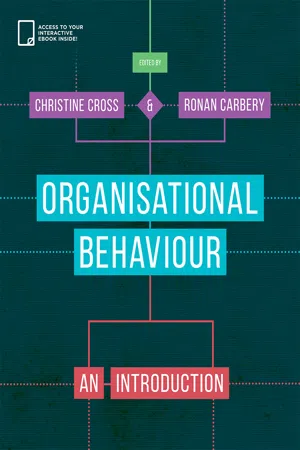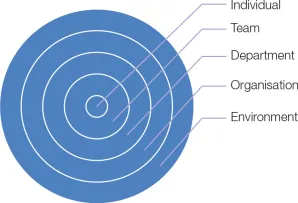
eBook - ePub
No longer available
Organisational Behaviour
An Introduction
Christine Cross, Ronan Carbery
This book isn’t in the library right now, search for another
- English
- ePUB (mobile friendly)
- Available on iOS & Android
eBook - ePub
No longer available
Organisational Behaviour
An Introduction
Christine Cross, Ronan Carbery
Book details
Book preview
Table of contents
Citations
About This Book
A refreshing new introduction to organizational behaviour, outlining all of the key concepts and demonstrating how multiple theories can be applied together in practice by being a managerial book with a critical approach and incorporating psychological perspectives. Innovative skills development exercises are integrated along with a focus on employability throughout.
Frequently asked questions
How do I cancel my subscription?
Can/how do I download books?
At the moment all of our mobile-responsive ePub books are available to download via the app. Most of our PDFs are also available to download and we're working on making the final remaining ones downloadable now. Learn more here.
What is the difference between the pricing plans?
Both plans give you full access to the library and all of Perlego’s features. The only differences are the price and subscription period: With the annual plan you’ll save around 30% compared to 12 months on the monthly plan.
What is Perlego?
We are an online textbook subscription service, where you can get access to an entire online library for less than the price of a single book per month. With over 1 million books across 1000+ topics, we’ve got you covered! Learn more here.
Do you support text-to-speech?
Look out for the read-aloud symbol on your next book to see if you can listen to it. The read-aloud tool reads text aloud for you, highlighting the text as it is being read. You can pause it, speed it up and slow it down. Learn more here.
Is Organisational Behaviour an online PDF/ePUB?
Yes, you can access Organisational Behaviour by Christine Cross, Ronan Carbery in PDF and/or ePUB format, as well as other popular books in Negocios y empresa & Estrategia empresarial. We have over one million books available in our catalogue for you to explore.
Information
Topic
Negocios y empresaSubtopic
Estrategia empresarial1 | INTRODUCING ORGANISATIONAL BEHAVIOUR |
LEARNING OUTCOMES
BY THE END OF THIS CHAPTER YOU SHOULD BE ABLE TO:







© iStock.com/Rawpixel Ltd
THIS CHAPTER DISCUSSES…
What is organisational behaviour (OB)? 3 | Why does OB matter? 4 | Where does OB knowledge come from? 7 | Research methods in OB 8 | Historical perspectives of OB 10 | Why is OB more important today than ever? 15

When faced with difficult problems, when in need of the next product, or when trying to improve processes in workplaces, businesses commonly establish working groups to brainstorm and come up with creative ideas. The perception is that this is the best way forward, but in reality nearly all research studies (Pauhus et al., 1993) have found that group brainstorming leads to the generation of fewer ideas than comparable numbers of solitary brainstormers in both laboratory and organisational settings. Why might this be the case? First, sometimes people slack off in groups expecting other team members to take the lead. Most often it’s the most extraverted person who shares their ideas, not necessarily the person with the most or best ideas. Quite often people are hesitant to share ideas for fear of saying something stupid – they worry they’ll be judged by others. Other times people get blocked by what someone else said or only come up with ideas that are similar to those already proposed. Research suggests that brainstorming is most effective when individuals take time to process the problem or opportunity individually and bring their ideas to the group afterwards. If group brainstorming is to be used, groups need to make sure that the leader does not share his or her idea first but instead defers judgement, focusing on trying to come up with as many ideas as possible, regardless of their quality. Additionally, the use of trained facilitators, diversity in team members, and the creation of a ‘playground’ where members feel a sense of play and positive emotion while engaging in creativity may reduce some of the threats to group creativity (Thompson, 2003).
INTRODUCTION
What makes employees see their work in different ways? How do these differences affect their motivation and satisfaction with the job? Would they respond differently to rewards, different types of leadership or structures at work? How would they work together? If you have ever wondered about how people act and think the way they do in the workplace, you have been thinking about organisational behaviour (OB), probably without knowing it. By studying concepts and research in OB you will be able to understand and ultimately affect attitudes and behaviours at your current or future place of work.
This chapter provides an introduction and background to the field of OB. It is broken down into four important questions to consider when studying organisational behaviour:
1What is OB?
2Why does OB matter?
3Where does OB knowledge come from?
4Why is OB more important today than ever?
Addressing these questions will give you a solid basis for understanding the topics covered in the rest of the book.
WHAT IS ORGANISATIONAL BEHAVIOUR (OB)?
What is this business about ‘organisational behaviour’? Do organisations really behave? Perhaps not, but people certainly do. The field of OB is really about understanding how people think, act and react in the workplace, and the influence of many factors on their behaviour. These factors include issues around individuals, their relationships with others such as their co-workers and boss, the group or department they are in, and the structure and culture of the organisations they work in. As a discipline, OB is ultimately concerned with using this information to promote certain desirable employee attitudes and behaviours, as well as the effectiveness of the organisation more broadly. Because these factors around people, their relationships, and the broader organisational context all affect how they act in the workplace, the field, then, is inherently multi-level. By multi-level we mean that individuals operate within groups, and groups operate within organisations, and likewise organisations operate within a larger environmental context. If we fail to take the contexts into consideration we are missing a key piece of the puzzle.
organisational behaviour is a field of study which seeks to understand and improve organisational effectiveness by examining factors such as individuals, teams, and organisational culture and structure and the way they interact
We cannot understand one employee in isolation. Individuals are part of a team and the team influences that individual. For example, if everyone in Bob’s team is in a really grumpy mood that is likely to influence Bob and he’ll probably be feeling the same way by the end of the day even though he woke up in a great mood. Likewise, Bob’s input, personality, knowledge and so on, has an influence on his team. And we see that teams are part of departments and departments are part of organisations with their own history, values, culture, policies and so on. And finally, the whole organisation is all part of a larger environmental context including the market, economic situation, local, national and global regulations and national culture(s). These influences go from top down, for example from the environment or the organisation on the individual, or from bottom up, from the individual to the organisation (see Figure 1.1).

Figure 1.1 The multi-level nature of the field of OB
While studying OB, it’s useful to take a systems thinking approach. This basically means that if we want to understand a problem, we need to keep in mind how that problem is part of an overall system. In the context of organisational behaviour, systems thinking helps us to realise that an organisation is made of different parts that affect and are affected by one another. Similarly the organisation interacts with its larger environment. Systems thinking has its roots in general systems theory, which was originally developed from the physical sciences. Ludwig von Bertalanffy (1968) and Kast and Rosenzweig (1972) , who later brought this to the field of OB, suggested that a system is a complex structure of interacting elements which are open to, and interact with their environment. Systems theory suggests that the organisation is a system made of interrelated and interdependent parts. One can study each component in isolation, but when we do so, we fail to capture the essence of the whole.
systems thinking is an approach that considers the organisation as a system made of different parts that affect and are affected by one another. Similarly the organisation interacts with its larger environment
As you read this chapter, be sure to keep in mind what level the material is focused on – is it the individual, the team, or the organisation? – and remember that they are all influenced by and influence other levels. Similarly, as you are reading each of the chapters in the textbook, i...
Table of contents
- Cover
- Half Title
- Title Page
- Copyright
- Contents
- List of figures
- List of tables
- About the editors
- About the contributors
- Foreword
- Preface and editors’ acknowledgements
- Tour of the book
- Digital resources
- About the Spotlight on Skills contributors
- Active Case Study grid
- Building your skills
- Publisher’s acknowledgements
- Chapter One – Introducing organisational behaviour
- Chapter Two – Personality
- Chapter Three – Perception
- Chapter Four – Work-related attitudes and values
- Chapter Five – Motivation in the workplace
- Chapter Six – Emotions and the workplace
- Chapter Seven – Groups and teams in the workplace
- Chapter Eight – Leadership
- Chapter Nine – Power, politics and conflict at work
- Chapter Ten – Communication in the workplace
- Chapter Eleven – Organisational structure
- Chapter Twelve – Understanding organisational culture
- Chapter Thirteen – Managing organisational change
- Glossary
- Bibliography
- Index